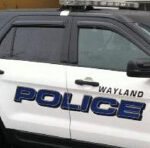The Board of Public Works voted unanimously on June 20 to maintain current water rates for fiscal 2026 following an extended discussion about the use of contingency funds and retained earnings. The vote came after a public hearing that drew no new public comments beyond those made during the board’s regular session.
Resident Tom Sciacca raised concerns during public comment about elevated PFAS levels in the latest water quality report, calling the detected 19.61ppt level “scientifically indistinguishable” from the 20ppt (parts per trillion) limit and urging the board to be more transparent about its implications. He also encouraged the Department of Public Works to utilize new meter data to alert homeowners to water overuse or potential leaks, citing a past incident of flooding damage in his basement. Sciacca further suggested that the transfer station be partially funded through the town budget, citing its value to long-time and older residents.
Chair George Uveges explained that the contingency fund, which was budgeted at $200,000 in FY26, is a line item in the annual operating budget used to cover unexpected costs, such as MWRA emergency water purchases. Retained earnings, by contrast, are derived from an accumulated surplus or shortfall in revenue budget and are used for unforeseen capital expenses.
The board then resumed deliberation on the water rate model. Uveges argued that projected expenses and retained earnings use must be included in the Annual Town Meeting warrant to remain compliant with Department of Revenue guidance, echoing advice from town finance director Brian Keveny.
Michael Wegerbauer countered that the board had historically included retained earnings as a funding source without explicit warrant language. Wegerbauer said the board’s approach was consistent with past practice.
Consultant Matthew Abrahams confirmed that the FY25 rate-setting model had excluded the $200,000 contingency, effectively under-projecting expenses. Uveges stressed that the resulting loss would further reduce retained earnings, which had already been drawn down by the board’s decision to lower its target from 22% to 20%. Wegerbauer defended the reduction, noting that retained earnings above the 20% target should be used to stabilize rates.
To offset the projected shortfall without raising rates, the board modeled a 6% increase in water consumption based on improved meter accuracy from the Advanced Metering Infrastructure (AMI) project. The board agreed this would likely generate enough additional revenue to break even, even with contingency included, and still maintain retained earnings slightly above the 20% target. Wegerbauer objected to treating the contingency as a real expense, calling it a “false projection,” but ultimately supported the no-increase proposal, citing likely overperformance in meter-driven revenue.
The FY26 water rate hearing opened and closed with no additional public input. The board voted 4-0 to maintain current rates.
Regarding future debt financing, the board reviewed Abrahams’s debt projections, which show outstanding debt rising from $15 million in 2024 to $43 million by the end of 2029, with $31 million attributed to the dual-source water supply project. Uveges and Wegerbauer agreed that using exempt debt funded through real estate taxes would be preferable to shifting the cost burden to water ratepayers. They noted that the Select Board retains the authority to reassign the funding source, creating long-term uncertainty.
During the director’s update, DPW Director Tom Holder reported that the AMI meter replacement program was 78% complete, with full completion expected by the end of October. Only three households have opted out of the meter wireless communication module, which turns off leak detection alerts and renders them ineligible for water abatements. Those households will also be billed quarterly, but at a rate of $20 per reading. Holder confirmed that the town owns the residential water meters and retains the legal right to enter property for meter replacement and installation.
Design approval from MassDEP is pending for the water tank replacement project, with bidding expected in July and construction scheduled to begin in October. The project is fully funded through previously approved appropriations and is scheduled for completion in fall 2026.
Holder also updated the board on the Reeves Hill pressure booster station, which serves around 140 residences. The contract was bid and awarded to Weston and Sampson. Construction is expected to begin in July and last seven months. The project is funded through enterprise capital appropriations and surplus from closed capital projects.
The Baldwin Pond Water Treatment Plant is currently operating at half capacity due to the failure of one of its two membrane skid rigs, which cannot pass required integrity tests. The DPW is now pursuing a temporary workaround by reallocating functional membrane fiber canisters from the broken skid to the operational one.
This fix could increase output from the current 600 gallons per minute to about 800 gallons per minute. The town is working with an engineer from Koch Separation Solutions, the manufacturer of the membranes, and has also improved manganese removal performance through recent upgrades to the ozone disinfection system. However, until the membrane issue is fully resolved, the plant will remain limited in its water production capacity.
The board briefly revisited concerns about the proposed revision to Chapter 193 of the town’s stormwater bylaw. Town Engineer Abby Charest submitted formal comments to the Conservation Commission outlining DPW’s recommendations for streamlining permitting and exempting emergency work. Uveges praised Charest’s letter and flagged the risk of construction delays if conservation requirements become overly burdensome.
Members continued debating the evaluation of townwide curbside trash pickup as an alternative or complement to the existing transfer station model. Michael Spelman expressed concern that a town-wide trash pickup service could reduce participation in the transfer station, especially if the town subsidizes curbside pickup. Wegerbauer echoed those concerns on the impact on the financial stability of the transfer station.
Uveges countered that the study could identify new revenue opportunities and reduce the number of trash haulers operating on the roads. Holder said the department would prepare a draft Request for Qualifications based on a similar initiative in Needham for a future meeting.















